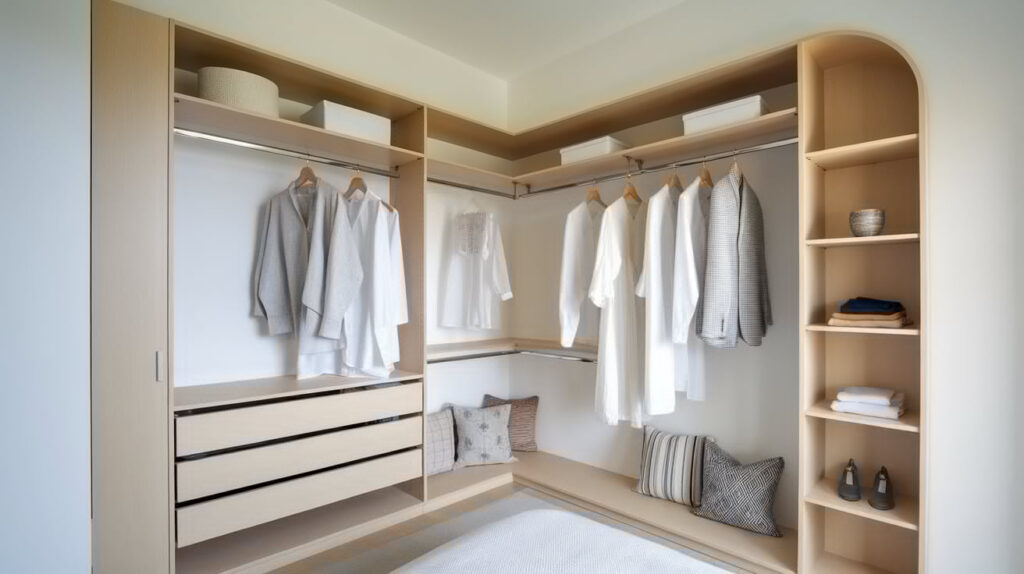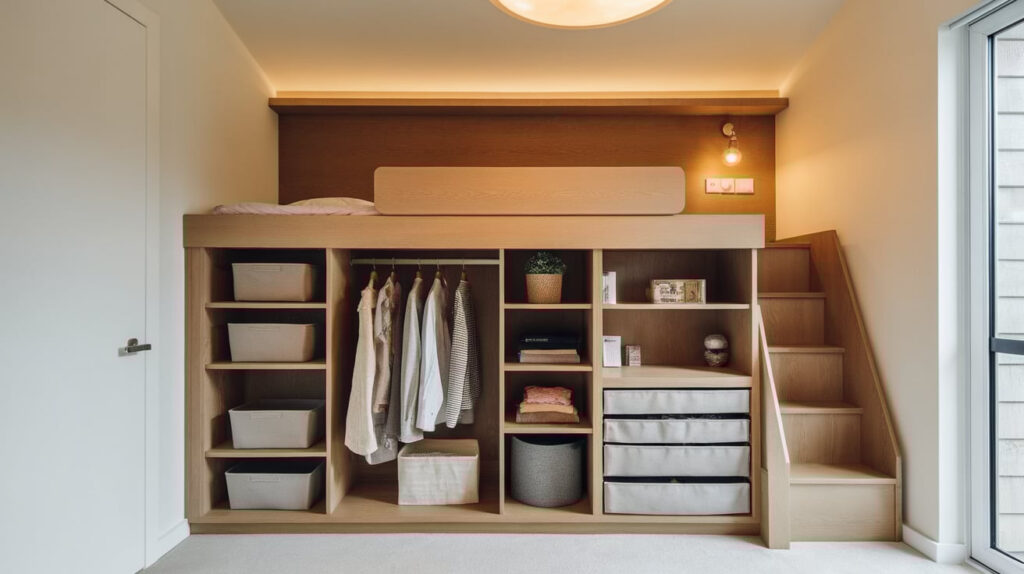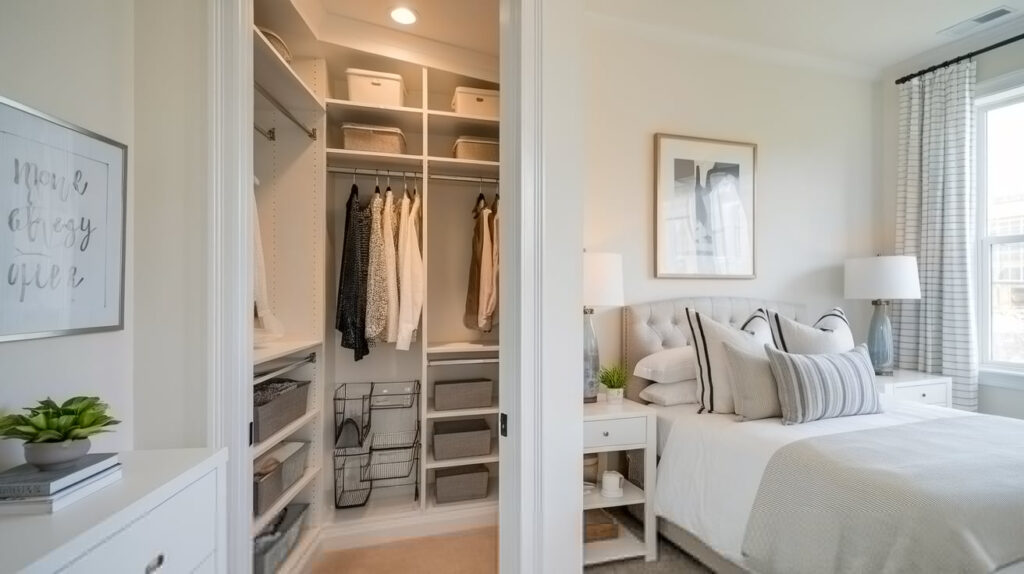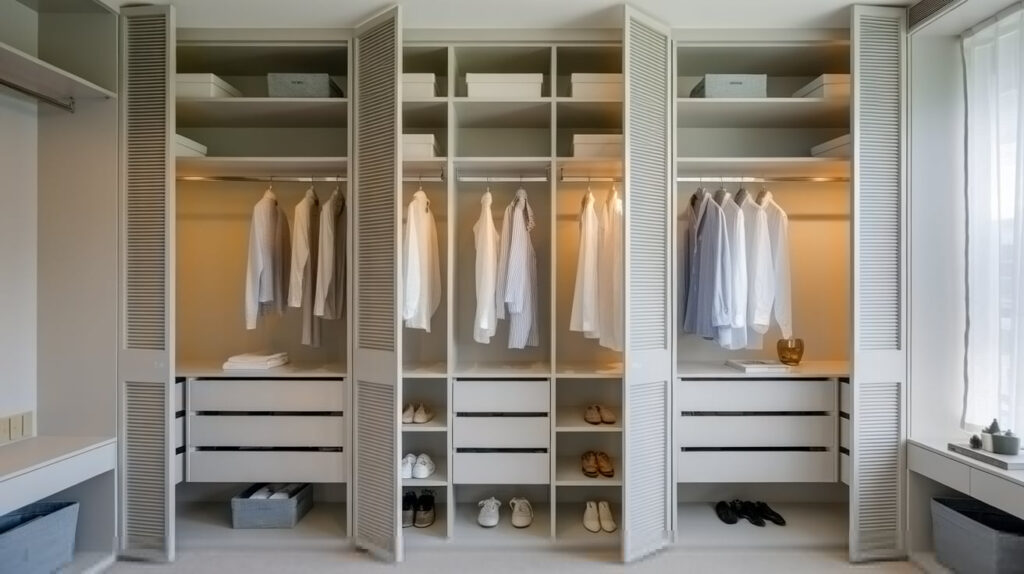Living with a tiny bedroom doesn’t mean you have to settle for limited storage. The right closet solution can transform your small space while keeping your clothes and accessories organized. In this guide, we’ll show you 7 smart ways to add functional closet space to even the smallest bedrooms.
We understand the frustration of not having enough storage-clothes piled on chairs, shoes scattered across the floor, and accessories lost in drawers. That stops today. As home organization experts with over 15 years of experience fitting closets into challenging spaces, we’ve tested countless solutions and narrowed down what truly works.
From measuring your space correctly to choosing between built-in and freestanding options, we’ll walk you through each step of planning and creating the perfect closet for your small bedroom. Let’s get started!
7 Genius Closet Ideas for Small Bedrooms
Here are some ideas, let’s dive in:
1. Create a Closet Wall with Sliding or Barn Doors

Turn any flat wall into valuable storage space.
I’ve seen dozens of small bedrooms transformed with this simple solution. You can use an entire wall to build a shallow closet that holds your clothes without taking up much floor space.
Want to know the best part? Sliding doors.
Unlike regular doors that swing open and need clearance space, sliding doors move sideways against the wall. This saves you precious square footage in your small bedroom.
What you’ll need:
- Basic wall framing materials
- Drywall
- Interior closet organizers
- Sliding door hardware or barn door kit
- Door panels of your choice
The ideal depth for these closets is 24 inches, but I’ve installed ones as shallow as 18 inches that still hold hanging clothes perfectly. You can make it work!
For extra style points, consider:
- Frosted glass doors for a modern look
- Reclaimed wood for barn doors with character
- Mirrored panels that make your room look bigger
My tip: If your ceiling is at least 8 feet high, add a top shelf above the hanging rod. This space is perfect for storing seasonal items or things you don’t use often.
Have you measured your wall yet? That’s your first step. Mark the space with tape on your floor to get a feel for how much room your new closet will take.
2. Repurpose an Alcove or Niche

Look around your bedroom. Do you have a wall recess going unused?
I’ve helped many clients turn these odd spaces into perfect mini-closets. That strange alcove between the walls can become your new favorite storage spot.
Wall recesses are ready-made for clothing rods and shelves. You don’t need to build an entire structure-the walls are already there!
Some quick ways to transform your niche:
- Install a simple rod across the width
- Add floating shelves for folded items
- Place hooks on the back wall for bags and hats
Not sure if your space is big enough? Even a 24-inch wide niche can hold a surprising amount of clothes.
When you want to hide your items, try these easy solutions:
- Tension rods with curtains
- Lightweight bifold doors
- A decorative room screen
My go-to tip: Paint the inside of your niche a different color. This makes it feel like a custom feature rather than a quick fix.
3. Use Freestanding Wardrobes or Modular Units

No construction skills? No problem.
I rent my apartment and can’t make big changes. Maybe you’re in the same boat. Freestanding closet options give you all the storage without any wall damage.
Modular units are my top pick for small spaces. You can start small and add pieces as needed.
Your best options include:
- IKEA PAX systems that fit your exact space
- Open garment racks with wheels (move them when cleaning!)
- Armoires that double as TV stands or desks
- Stacking cubes that grow with your needs
The best part? You can take these with you when you move.
Wait-did you know? Many freestanding units now come with mirrors, jewelry drawers, and shoe racks built in.
Pro tip: Measure your doorways before buying! I once purchased a beautiful wardrobe that wouldn’t fit through my bedroom door. Learn from my mistake.
4. Build a Corner Closet with L-Shaped Units

Corners are storage gold mines in small rooms.
I’ve found that most people ignore corners, but they’re perfect spots for L-shaped closets. You get two walls of storage while using space that usually collects dust.
Corner closets make sense because they:
- Use dead space that furniture can’t usually fill
- Create more hanging room than straight closets
- Allow for creative storage configurations
Here’s what works best:
- Dual hanging rods on both walls
- A corner shelf unit that turns the angle into useful space
- Angled shoe shelves that display footwear efficiently
My design secret: Add a small vanity or dresser in the open space in front of your corner closet. This creates a complete dressing area in one compact zone.
How about lighting? Battery-powered stick-on lights make dark corners bright and functional.
5. Install a Closet Under a Loft or Raised Bed

Sleep high, store low.
I tell clients with truly tiny rooms to think in 3D. Your floor space can serve two purposes when you lift your bed off the ground.
You gain an entire room’s worth of storage underneath a loft bed. For adults or teens, a full loft with 6+ feet of clearance works best.
What can you fit underneath?
- A full rod for hanging clothes
- Drawers for folded items
- Shoe racks along the back wall
- A small dresser or vanity
For kids’ rooms or spaces with lower ceilings, try a mid-height bed with 3-4 feet of clearance.
Fair warning: Make sure your ceiling is high enough! You need at least 3 feet between the mattress and the ceiling for comfortable sitting.
My practical advice: Install casters on any drawers or bins that go under the bed. This makes access much easier when you need to pull things out.
6. Convert an Adjacent Nook or Hallway

Think outside the bedroom box.
I often find storage solutions hiding just outside the bedroom door. That small hallway or nook nearby might be your answer.
You can claim these spaces for your clothes when:
- They’re not heavily used as walkways
- They’re close enough to feel connected to your bedroom
- They have at least one solid wall for mounting storage
Your options include:
- Built-in shallow cabinets (just 12″ deep work!)
- Wall-mounted open closet systems
- A row of hooks with a bench below
How do you make it feel like part of your room? Sliding panels, curtains, or matching paint colors create a visual connection.
Quick tip: Add a full-length mirror on the outside of your hallway closet. This creates a dressing area and makes the space feel planned, not makeshift.
7. Maximize Vertical Space with Closet Towers

The sky’s the limit-or at least your ceiling is.
I’m always surprised by how much floor space people save by building up instead of out. Vertical storage towers use your room’s height while keeping the footprint small.
Closet towers work well because:
- They use space that’s normally wasted
- They keep items sorted in logical sections
- They can fit in corners or flat against walls
What to store in your towers:
- Shoes (toe-out on slanted shelves)
- Folded sweaters and jeans
- Bins for small items like socks
- Out-of-season clothes on top shelves
Remember this: Items you use daily should sit between your waist and eye level. Less-used items go up high or down low.
My number one tip: Add a small step stool that fits inside or beside your tower. You’ll use those top shelves much more when they’re easy to reach!
Design Tips When Adding a Closet to a Small Bedroom
Light Colors and Mirrors
- Use white or cream for closet interiors
- Choose pale neutrals for doors and external surfaces
- Match built-ins to your wall color
- Add mirrors on closet doors or opposite walls
- Position mirrors to reflect windows for more light
Lighting Solutions
- Install battery-powered LED pucks for easy installation
- Use motion-sensor strips to save fumbling for switches
- Consider plug-in closet rods with built-in lighting
- Choose “soft white” bulbs (2700-3000K) to show true colors
- Place lights at different heights to reduce shadows
Smart Storage
- Switch to slim velvet hangers to fit 40% more clothes
- Select matching bins for visual consistency
- Use clear containers for items you need to see
- Label everything for easy organization
- Add small hooks for belts, scarves, and jewelry
- Take 5 minutes daily to maintain order
Low-Cost Ways to Add a Closet in Tight Spaces
DIY with Tension Rods and Stackable Organizers
- Install tension rods between walls or in alcoves for instant hanging space
- Use multiple rods at different heights to double your storage
- Add fabric hanging organizers for folded clothes and accessories
- Stack milk crates or wooden boxes for shoes and bags
- Try command hooks on walls when drilling isn’t possible
Thrift or Upcycle Wardrobes and Cabinets
- Check thrift stores for solid wood wardrobes at 1/4 retail price
- Look for kitchen cabinets to repurpose as clothing storage
- Paint mismatched pieces the same color for a cohesive look
- Add new hardware to refresh old furniture
- Remove doors from bookcases to create open clothing displays
Open Racks and Stylish Curtains
- Mount simple pipe rods to walls for industrial-style open closets
- Hang floor-to-ceiling curtains to cover clothing storage areas
- Use decorative room dividers to section off a clothing corner
- Try shower curtain rods in U-shapes to create closet nooks
- Add baskets underneath hanging clothes for shoes and extras
Conclusion
Small rooms can have great storage with thoughtful planning. I’ve seen tiny bedrooms transformed with smart closet solutions that maximize space without making rooms feel cramped.
Focus on your actual needs, not what catalogs suggest. Your storage should reflect your real life, not an ideal version of it.
Start with the function first, then add your personal touches. A closet that works well becomes even better when it reflects your style.
Remember vertical space-look up for extra storage. Most people forget about the upper third of their walls.
Break the rules when needed-your space should work for you. Sometimes the best solution isn’t in any design book.

